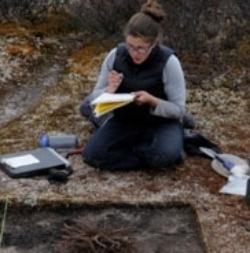Chelsee Arbour

Previous Education
M.A. (Anthropology), Trent University, 2011
B.A. (Anthropology), McGill University, 2008
Supervisor
Keywords
The first peoples of the Québec/Labrador peninsula, Indigenous peoples of northeastern North America, quartz and lithic studies, narrative construction and discourse studies, knowledge practices, community-oriented archaeology.
Research Statement
My research is part of the larger Caribou House Project, a community-oriented collaborative project by the Tshikapisk Foundation, an Innu non-profit cultural heritage organization, in association with the Arctic Studies Center of the Smithsonian Institution, under the auspices of the Innu Nation, and with support from the communities of Sheshatshiu and Natuashish. My role in this larger project is to investigate the numerous and predominantly quartz assemblages of some of the earliest occupations at Kamestastin Lake. Within the last decade, investigations in the Kamestastin region have produced evidence of 260 sites spanning a 7000 year period, suggesting continuous – albeit episodic – occupation at Kamestastin Lake and the surrounding area from the time of deglaciation to the present. The unique archaeological signature of Kamestastin is not, however, the only reason why this region is significant. Kamestastin is located in the heartlands of the Mushuau Innu, the most northern of the Innu regional groups. These early sites, and the Kamestastin region as a whole, figure prominently within contemporary Mushuau Innu personal experiences (such as the seasonal goose and caribou hunt), oral histories within contemporary generational memory, and oral traditions embedded in myths and epic travel accounts that have been passed down over many generations. In this way, the sites and find-spots on the land are tangible traces of the Mushuau Innu ancestors and part of the larger narrative of Innu deep history. Thus at a more refined scale, my research has been to balance a very detail oriented archaeological analysis of the earliest campsites, focusing on the use of quartz, with a multi-vocal approach that allows for the exploration of how quartz is engaged with or storied by different audiences (including Innu oral histories and personal experiences, Innu oral traditions, and archaeology). Such a collection of voices provides a platform to understand how differing narrative practices story, engage with, and understand ‘the deep past’, the place of quartz within some archaeological and Innu frameworks, and potential future directions for community-based work in the Québec/Labrador peninsula.
Contact
Email: csa413@mun.ca
Phone: 709-864-2451
Instructor Office: QC-2014